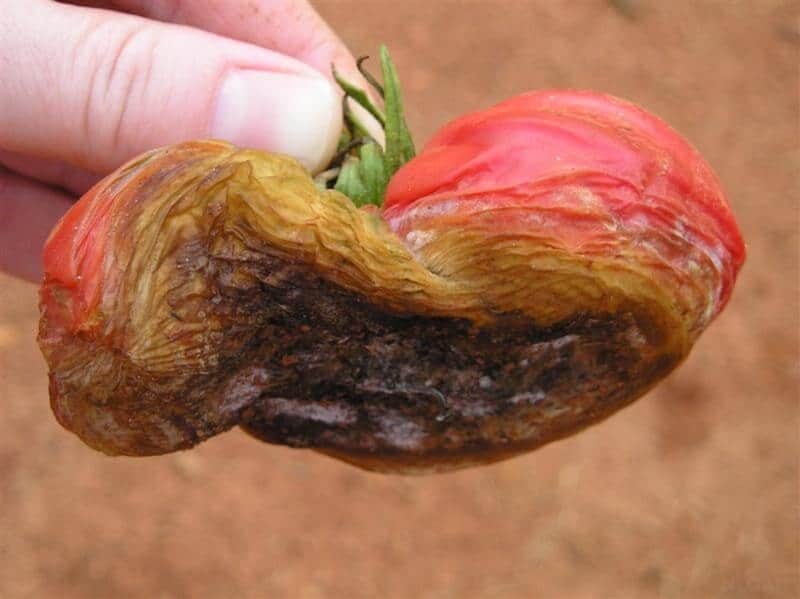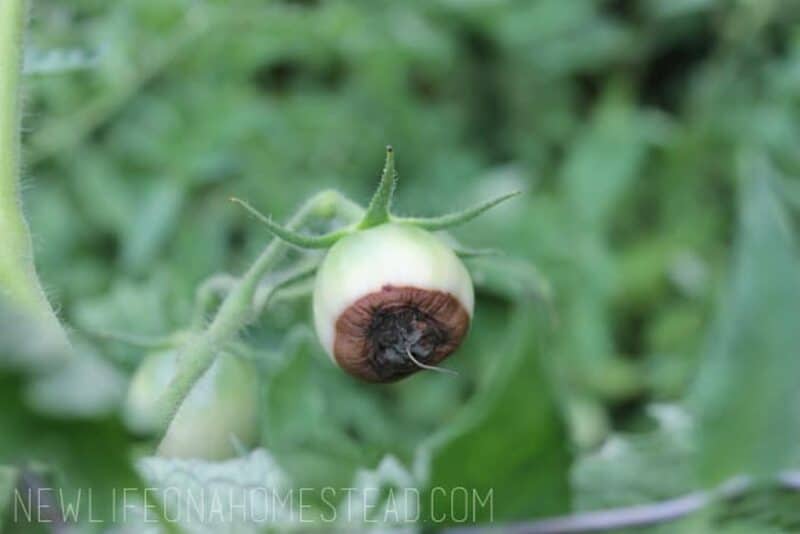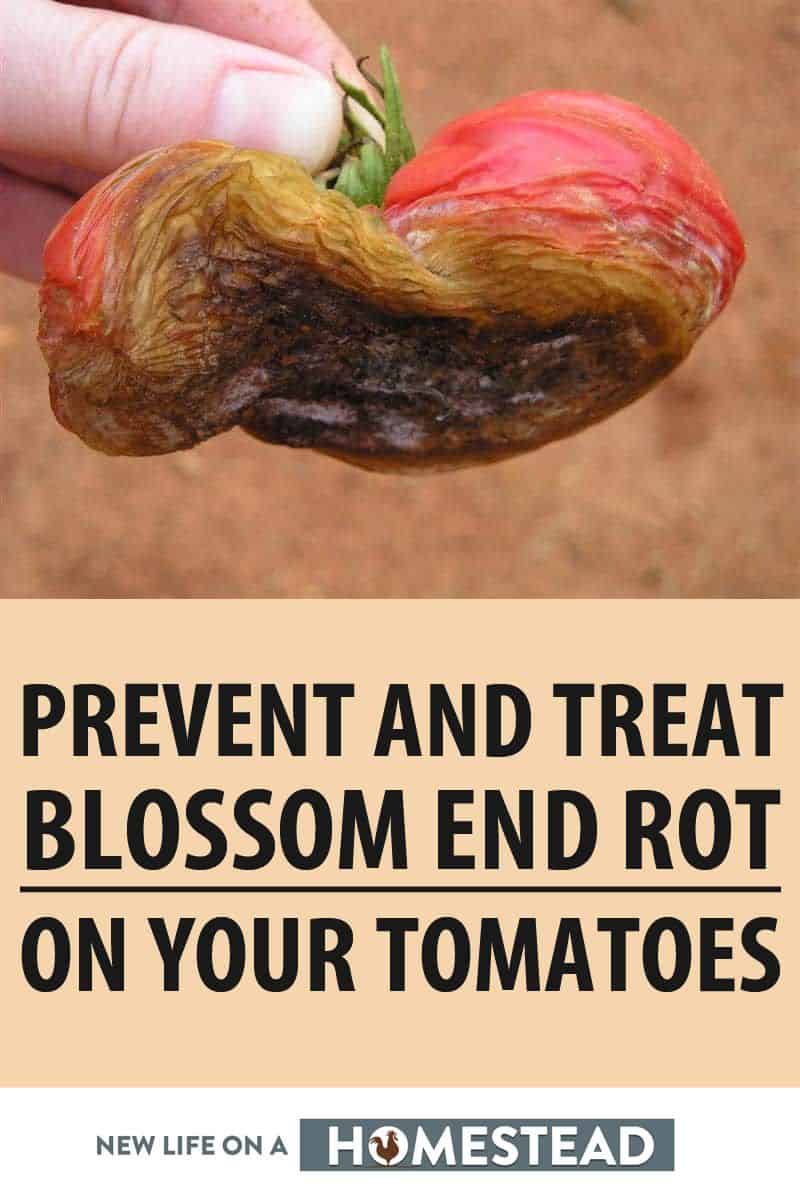I was all excited when I saw my beautiful round tomatoes turning red. I couldn’t wait to cut one up and enjoy the fruits of my labor! Then, just as they were turning a nice shade of red, I noticed something devastating… my tomatoes are rotting!
They look all nice from the top, but as soon as I go to pick one I realize that the whole bottom of it is rotten and moldy. Yuck!

I called my mother-in-law (as I do with all of my homemaking questions!) and described to her what the tomatoes looked like. She quickly diagnosed my problem:
Tomato Rot (also know as Blossom-end Rot).
She suggested that I pick the bad ones off the plant; and don’t throw them in the compost pile.
Well, at least the tomatoes in the goats pen are still lookin’ good!
Blossom end rot is a major pain, but luckily, there are some easy ways you can prevent and treat it in your garden before it kills all of your tomato plants.
What is Blossom End Rot?
Blossom end rot is a major pain, but luckily, it’s something that you can easily address. It’s a serious disorder shared by eggplant, cucumber, pepper, and tomato plants. Some people believe it’s a fungal disease, but that’s not the case.
As I mentioned, blossom end rot is, more often than not, caused by uneven watering or by calcium deficiency. Sometimes, these problems are related. If you don’t water evenly, it can affect how your plants take in calcium.
Blossom end rot is often brough ton or worsened by drought, high levels of salt in the soil, or the use of too much fertilizer.
You’ll know it’s blossom end rot when you notice symptoms like brown spots on fruit that appear leathery and sunken in. In some severe cases, secondary infections could strike your plant. Usually, these appear like fuzzy growths and can cause the plant to rot entirely.
Unfortunately, blossom end rot can occur even when there is plenty of calcium in the soil, leaves, and stems o the plant. The plant is simply not transferring that calcium effectively to the ripening tomato. This is why proper watering is so important. Calcium is only moved to the various parts of the plant when there is ample water.
Luckily, blossom end rot isn’t known to spread between plants. If you have one plant suffering from blossom end rot, it isn’t going to spread it to others (although it can easily affect multiple plants, as the causative factors for one plant tend to be there for the others, too).
Usually, blossom end rot appears when your fruit is either still green or in the process of ripening. It most often strikes the first fruits that appear on the plant, so if you’re able to catch it early enough, you might be able to prevent it from worsening.

9 Ways to Prevent Blossom End Rot
Amend Your Soil
Before planting, take the time to amend your soil. Tomatoes grow best in soil that is well-draining and rich in organic matter. Ideally, your pH should be around 6.5 to 7,.5 before you plant. Do a soil test and use a fertilizer hat will meet the unique needs of your plants.
Grow Resistant Varieties
If you can, select seeds and transplants that are grown from rot-resistant varieties. This won’t guarantee that your plants will be free from blossom end rot, but it can definitely improve your odds.
Watch Your Watering
Be careful about how you water your plants. Good watering hygiene is essential! Water first thing in the morning so your plants have plenty of time to dry out. Keep the soil evenly moist and consider spraying your plants with a calcium spray.
If you have a hard time monitoring soil moisture, you may want to consider adding a layer of mulch. This should conserve soil moisture during the hottest, driest periods of the summer.
Plants need about an inch to an inch of a half of water each week while they are fruiting. The best way to water tomatoes that are planted directly in the ground is to use a soaker hose. No matter what, keep your tomato plants well-watered during the summer months!
If you’re growing your tomatoes in containers, they are going to dry out more quickly. Potted plants should be thoroughly drenched with water each and every day, particularly during a heat wave.
Drip irrigation is another watering technique you can use. This will help prevent your soil from drying out completely and will instead supply water exactly where and when it is needed most.
Add Shade
If moisture stress is an issue, you might want to do what you can to eliminate too much sunlight. Shade the plants when it’s hot. Something as simple as shade cloth can do the trick.
Avoid Nitrogen-Heavy Fertilizer
Try to avoid using synthetic fertilizers that contain large amounts of nitrogen. These increase vegetative growth (which isn’t something you necessarily want for your tomato plants, anyway) and reduce y our plants’ abilities to take up calcium. Instead, use a more well-balanced organic fertilizer to feed your plants.
Plus, fertilizers that are heavy in nitrogen will encourage your plants to grow rapidly early on. the calcium, is needed most by the tomatoes when they are actively growing and your plants may not be able to replace the calcium quickly enough.
Be Careful About Damaging Your Plant Roots
Root damage can lead to impaired moisture intake, so make sure you’re careful when weeding near your plants. You also have to be careful about burning plant roots with fertilizer. Even waterlogged oils can affect the roots’ ability to take in nutrients.
Remove Infected Fruits
If you happen to notice plants with rotten spots, remove them. Like I said, blossom end rot won’t spread from plant to plant, but there’s no reason to allow your plant to continue pushing nutrients to a fruit that will never ripen properly.
Let the Soil Warm
Before planting, make sure your soil has adequately warmed. This will improve the ability of your plants to take in nutrients, as cold soil limits uptake.
Use Egg Shells and Coffee Grounds
Here’s how I prevent Blossom End Rot in my garden.
It’s simple, and free.
I save my cracked egg shells and used coffee grounds, set them out in the sun to dry, then sprinkle them liberally around the base of my tomato and pepper plants. Since I’ve been doing this, I’ve never had a problem with Blossom End Rot. Highly recommend!
Other things you can add to boost soil fertility when you start planting your tomatoes include oyster shell, bone meal, and gypsum. These will usually prevent problems related to calcium deficiency from occurring.
How to Get Rid of Blossom End Rot
Often, blossom end rot will clear up on its own as the growing season progresses. If you notice fruits that suffered from the disease, you can pick them off and discard them. Cutting the bad spots out of the affected plants and eating the rest won’t hurt you, either.
As a sort of stop gap measure, you may be able to halt blossom end rot by spraying tomato plants with a calcium solution. This will usually be marketed for and designed specifically to treat blossom end rot. You can apply it two or three times a week as soon as the first blooms appear.
This kind of solution won’t permanently get rid of the issue, but it may help you save your crop until you’re able to rectify the problem for good.
Another hack you can try is watering with powdered milk. This will supply calcium – immediately. Egg shells are awesome but the calcium won’t be picked up by your tomato plants until they start to decompose. Therefore, you should consider mixing powdered milk into your watering can to add a quick boost of nutrients.
Plan Ahead so Blossom End Rot is Never a Problem
Blossom end rot is not fun to deal with, but luckily, it’s a condition that can be easily prevented. If you’re suffering from this frustrating condition in your garden, consider following these tips so that you never have to deal with it again.
And remember, it will be super helpful if you can keep good garden records between growing seasons. You may figure out where you went wrong and how you can prevent and treat blossom end rot in the future!
updated 06/23/2020 by Rebekah Pierce


A city girl learning to homestead on an acre of land in the country. Wife and homeschooling mother of four. Enjoying life, and everything that has to do with self sufficient living.

This site may be of help to you:
Hi! I was surfing and found your blog post… nice! I love your blog. 🙂 Cheers! Sandra. R.
didn’t really have time to read all suggestions but supposedley if you mix some epson salt with some water the bag should have directions as to how much you should use, it will help with that!
Oh, and BER is more common on Roma-type tomatoes if I remember right…
I have no idea how to stop it after it starts, but I do save up all my eggshells throughout the year to throw in the tomato/pepper holes when I’m transplanting stuff outside. The kids think it’s great fun.
Forgot to add…..check your green tomatoes and pick off the ones rotting as well…..
From Mother Earth News:
“What you are seeing is a nutritional disorder called blossom-end rot. It is very common in early summer, when plants are growing rapidly and attempting to meet the demands placed on them by fruits. When they can’t pump quite enough nutrients to the fruits, the blossom end of the fruit develops rot spots. Naturally, the problem is most common with large-fruited tomatoes because it’s a farther trip from the stem attachment to the end of the fruit.
Acidic conditions make it difficult for tomatoes to take up calcium, so mixing dolomitic lime or slow-release rock phosphate into the soil, well before planting, will help to prevent this problem, if your soil is naturally acidic. Fluctuating soil moisture and too much nitrogen, which pushes the plants to grow, also contribute to the problem.
To reduce the disorder once it’s in progress, pick off affected fruits. Lightening the fruit load will make it easier for the plants to meet the needs of flawless specimens. Also pile on plenty of mulch, which will prevent fluctuations in soil moisture”
I have had this problem from time to time, and haven’t really tried anything. However, I just read something in our local paper about crushing egg shells and raking them around the plants. Might be worth a try….
Try crushing some eggshells and digging them in around the bases of your plants. They’ll slowly release calcium into the soil and keep your tomatoes happy. Also water every day that it doesn’t rain, and check the soil pH. They usually sell pH test kits at nurseries or hardware stores. Hope this helps!
I used crushed egg shells and powdered milk mixed into the soil around the plant, then watered in well to stop it…seemed to work for me!!
I had that problem, too. I read that mixing eggshells into the soil will help with the lack of calcium.
My tip- always pick tomatoes right before they turn red (like when they start to show a little pink). I know that vine rippened is ideal but it’s just safer to pick them early.
Have a blessed day,
Julie
This will sound silly, but it works for us. When I make hard-boiled eggs, I throw the shells in a sun-tea jar. Cover it with water and leave it out in the sun. Whenever I water the tomatoes, I use water from my sun-tea jar and then refill it. I just keep throwing egg shells in there all summer long. The calcium from the shells leaches into the water. You can also put a couple of crushed egg shells in the hole when you are planting the tomatoes. I haven’t had a problem with blossom-end rot since I started doing this. Good luck!
The instructor of the gardening class I’m currently taking just explained that sometimes, although you may get a few bad tomatoes on a plant with the blossom-end rot, sometimes after those have been removed, the plant will go on to produce healthy tomatoes. Hopefully that will happen for you and you can go on to get healthy tomatoes.
I forgot something. This fall after you pull up old plants you should put some lime in your soil. And, start putting egg shells in the compost pile. As long as you add lime/calcium to the soil every other year you should avoid blossom end rot.
Blossom end rot is a symptom of calcium deficiency, so I would go with Richard’s suggestion.
My sad looking tomatoes are the half eaten ones. I never see grasshoppers out there, but they are clearly present and loving the cherry tomatoes. If i pick them at the first sign of ripening, and bring them inside they are usually safe, but if I skip a day, I have sad little tomatoes. Any solution for them (that’s hopefully not straying the whole place with pestacides)
I’ve read that you can bury eggshells before you set the plant and that will solve blossom end rot.
If these are the first fruit this season, it may work itself out and be just fine. I usually put a cheap calcium antacid tablet in each hole as I plant the tomatoes, but even that doesn’t prevent at least a few fruit with BER. Other people put crushed egg shells in the holes or around the plants, but I never had enough shells!
It helps to know how much you water and if you’ve fertilized it at all. I bet that you have an issue with the ph level, because in a previous post you had mentioned that you forgot to fertilize. Also, you say that the tomatoes in the goat pen were doing great. IMO, I would try to fertilize the plants. I was told by a master gardener, that used coffee grounds are a great fertilizer for your plants. Keep your grounds from your morning coffee and put some around the base of each plant and leave it there. It worked wonders for my roses. Let me know if it works for your tomatoes. 🙂
I don’t know how quickly it works, but egg shells are great for a natural calcium boost in the soil. So sad to see your beautiful tomatoes end that way. We’ve had our share of garden disasters as well. Every year I learn a little more, and find there is a whole lot more I have yet to learn!
~Erin
I use a calcium spray on the whole plant. It works for me .